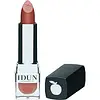What's inside
What's inside
 Key Ingredients
Key Ingredients

 Benefits
Benefits

No benefits
 Concerns
Concerns

 Ingredients Side-by-side
Ingredients Side-by-side

Diisostearyl Malate
EmollientCyclopentasiloxane
EmollientTrimethylsiloxysilicate
EmollientPhenyl Trimethicone
Skin ConditioningMethyl Trimethicone
Skin ConditioningPolyethylene
AbrasiveSilica
AbrasiveMethyl Methacrylate Crosspolymer
Quaternium-90 Bentonite
Menthyl Lactate
MaskingParaffin
PerfumingSorbitan Sesquioleate
EmulsifyingPolyisobutene
Illicium Verum Fruit Extract
Perfuming1,2-Hexanediol
Skin ConditioningCera Microcristallina
Emulsion StabilisingTriethoxycaprylylsilane
Vanillyl Butyl Ether
MaskingCI 77120
Cosmetic ColorantAluminum Hydroxide
EmollientColophonium
Propanediol
SolventCaprylyl Glycol
EmollientTocopheryl Acetate
AntioxidantCI 15850
Cosmetic ColorantCI 45410
Cosmetic ColorantCI 77491
Cosmetic ColorantCI 77492
Cosmetic ColorantCI 77499
Cosmetic ColorantCI 77891
Cosmetic ColorantMica
Cosmetic ColorantCI 42090
Cosmetic ColorantDiisostearyl Malate, Cyclopentasiloxane, Trimethylsiloxysilicate, Phenyl Trimethicone, Methyl Trimethicone, Polyethylene, Silica, Methyl Methacrylate Crosspolymer, Quaternium-90 Bentonite, Menthyl Lactate, Paraffin, Sorbitan Sesquioleate, Polyisobutene, Illicium Verum Fruit Extract, 1,2-Hexanediol, Cera Microcristallina, Triethoxycaprylylsilane, Vanillyl Butyl Ether, CI 77120, Aluminum Hydroxide, Colophonium, Propanediol, Caprylyl Glycol, Tocopheryl Acetate, CI 15850, CI 45410, CI 77491, CI 77492, CI 77499, CI 77891, Mica, CI 42090
Ingredients Explained
These ingredients are found in both products.
Ingredients higher up in an ingredient list are typically present in a larger amount.
Caprylyl Glycol is a humectant and emollient, meaning it attracts and preserves moisture.
It is a common ingredient in many products, especially those designed to hydrate skin. The primary benefits are retaining moisture, skin softening, and promoting a healthy skin barrier.
Though Caprylyl Glycol is an alcohol derived from fatty acids, it is not the kind that can dry out skin.
This ingredient is also used as a preservative to extend the life of products. It has slight antimicrobial properties.
Learn more about Caprylyl GlycolCera Microcristallina isn't fungal acne safe.
Ci 77491 is also hydrated iron III oxide. It's sole purpose is to give a red/pink hue to products.
Iron III oxides are classified as inorganic chemicals for coloring.
Synthetically created Ci 77491 is considered safer than those naturally found. This is because the synthetically created version may contain less impurities. Iron oxides are generally non-toxic and non-allergenic.
Learn more about CI 77491Ci 77492 is also hydrated iron III oxide. It's sole purpose is to give a yellow hue to products.
Iron III oxides are classified as inorganic chemicals for coloring.
Synthetically created Ci 77492 is considered safer than those naturally found. This is because the synthetically created version may contain less impurities. Iron oxides are generally non-toxic and non-allergenic.
Learn more about CI 77492Ci 77499 is also hydrated iron III oxide. It is created from mixing red and black iron oxides. This helps give shades of darkness to a product.
Iron III oxides are classified as inorganic chemicals for coloring.
Ci 77891 is a white pigment from Titanium dioxide. It is naturally found in minerals such as rutile and ilmenite.
It's main function is to add a white color to cosmetics. It can also be mixed with other colors to create different shades.
Ci 77891 is commonly found in sunscreens due to its ability to block UV rays.
Learn more about CI 77891Diisostearyl Malate is an emollient and most often used in lip products. It comes from isostearyl alcohol, a fatty acid, and malic acid, an AHA.
As an emollient, Diisostearyl Malate helps create a thin film on your skin to trap moisture in. This helps keep your skin soft and smooth.
Silica, also known as silicon dioxide, is a naturally occurring mineral. It is used as a fine, spherical, and porous powder in cosmetics.
Though it has exfoliant properties, the function of silica varies depending on the product.
The unique structure of silica enhances the spreadability and adds smoothness, making it a great texture enhancer.
It is also used as an active carrier, emulsifier, and mattifier due to its ability to absorb excess oil.
In some products, tiny microneedles called spicules are made from silica or hydrolyzed sponge. When you rub them in, they lightly polish away dead skin layers and enhance the penetration of active ingredients.
Learn more about SilicaTocopheryl Acetate is AKA Vitamin E. It is an antioxidant and protects your skin from free radicals. Free radicals damage the skin by breaking down collagen.
One study found using Tocopheryl Acetate with Vitamin C decreased the number of sunburned cells.
Tocopheryl Acetate is commonly found in both skincare and dietary supplements.
Learn more about Tocopheryl Acetate